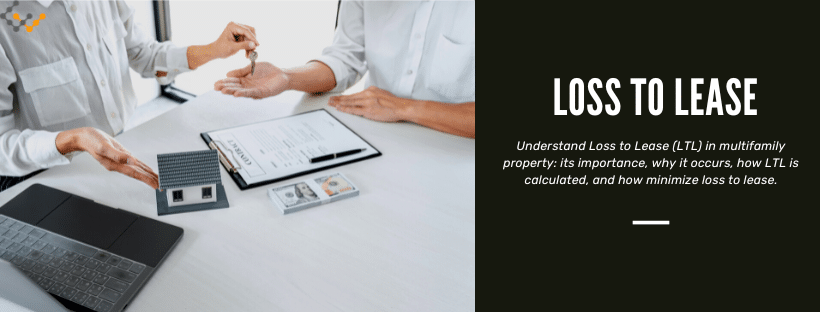Understanding Loss to Lease in Multifamily Property

Real estate investors must consider how much rent they can charge for a property prior to investing in the property. However, there is often a difference between what this estimate is and what the actual rent earned occurs. This is called the loss to lease, or LTL. It is an important calculation for all property investors to consider.
What Does Loss to Lease Mean?
Loss to lease refers to the difference between the actual rent on a property and what is considered the market rent.
Actual rent refers to the amount of rental cost charged to the tenant. By comparison, the market rent is the price that is considered what could be charged based on factors evident in the local market.
In situations in which the actual rent is lower than the market rent, this equates to a loss to lease, or the property owner is losing out on available rental income. In situations where the actual rental rate charged to the tenant is higher than the market rate, it is called a gain to lease.
This figure, typically used in multifamily property investments, is one metric investors can use to evaluate the return on investment as well as to make decisions in changing rental rates for tenants.
Answer a few questions and get custom mortgage quotes. We'll match you with offers from our network of 650+ lenders.
Importance of Loss to Lease to Multifamily Investors and Property Managers
Understanding LTL is critical to understanding the value and potential value of any property. In situations where an investor is looking at more than one property, this metric can provide insight into where the most gap or potential is present. A high loss to lease on a property means there may be a significant opportunity to increase rents to tenants if the investor purchases the property.
By comparison, if there is less of a gap between market value and actual value, this can indicate that there is less of an opportunity to increase rents, and what is being paid is close to the actual expected value for the property.
Why Does Loss to Lease Happen?
Loss to lease can occur for various reasons. It often occurs when a property owner offers concessions to existing tenants of the property, often by allowing a tenant to continue to remain at the property, thus keeping the rent lower overall. Discounts can also be a factor. For example, if a property owner wants to fill a vacant space, they may offer a free month on a 12-month contract, which ultimately reduces the total actual rent received.
The loss to lease is an opportunity loss, not one that has to be righted by the property owner in a sale. It creates an opportunity for the owner to increase rents and gain higher revenue from the property over time. It may require some work to get there, such as upgrades, but it ultimately allows for the property investor purchasing the property to have some leeway in increasing rents.
How is Loss to Lease Calculated
Loss to lease is simply the difference between actual rent and market rent rates. It is the difference between the existing, in-place rent and the amount of rent potential for the property. To obtain a percentage to allow for easy comparison between properties, consider the following.
Loss to Lease Formula
The actual formula for LTL is:
Market rental rate – actual rental rate divided by market rental rate = loss to lease in a percentage.
In situations where there is a positive percentage, that means that actual rent is higher than market rent. The property owner is achieving the likely highest or average rent for the property. If there is a negative percentage, that means market rent is higher than actual rent, meaning the tenant is benefiting from a lower cost (and there is room to increase rents).
Loss to Lease Example Calculation for a Multifamily Property
Consider a property that has a current monthly market rent of $2,000. However, the current tenant’s lease requires them to pay $1800 per month. This means that:
$2,000 – $1800 = $200 per month
This $200 represents the actual financial figure difference, but it is not a metric that is helpful. Rather, it is important to understand the percentage difference. To complete the formula, then, the current figure must be divided. That would mean that $2,000 divided by $200 is 10%.
How to Reduce Loss to Lease: 5 Strategies
The only way to reduce loss to lease is to raise rents. However, simply raising the rent to market level could lead to a loss of tenants, especially those that are paying for years below the current market rent or, in some cases, have a contract that offers them incentives to remain.
For this reason, property investors planning to move into the market must consider strategies to help them improve the property in some manner to increase rents. This could include:
- Replacing low-paying tenants with higher-paying tenants at market rents
- Improving the property to drive up rates
- Working to offer incentives that increase rental costs, such as free parking or amenities
- Increasing rents to match inflationary pressures
- Put in place shorter lease terms to allow for more frequent updates to rental rates
Common Challenges of Raising Rents
There are risks to raising rents to reach market rates, and this is critical for investors to consider before simply hiking rates.
First, increasing rates means that the current renter may not remain, and that could mean that the investor needs to replace that tenant. This can create a short-term negative effect if the property is not filled quickly.
Second, most lease renewals happen throughout the year, based on when each property tenant moved into the location. That means it is not possible to simply raise rents across the board at any given time to meet market value. Instead, it must be done on a lease-by-lease basis. That means it takes time, and as rents continue to change, it can be hard to hit this moving target in a meaningful and effective manner.
Loss to Lease vs Gain to Lease: Differences
Keep in mind that a loss to lease means that the market value of the property is higher than what is actually being paid by tenants living at that property. However, a gain to lease can also occur, in which the property is earning more than the expected market value for it.
A gain to lease shows the rents are at market level. That means that the rental property is reaching its potential for the market. If the property owner were to increase rents, they may be over the market value and may find it hard to obtain new tenants to fill vacancies. A high gain to lease value could mean the property is more desirable for some reason.
Wrapping Up
Loss to lease is a common metric used to evaluate the current rents paid by tenants, but it is not necessarily a negative one. It can indicate to investors that there is room to increase rents and, therefore, earn more revenue from the property than they may be being paid now. While raising rates is not a simple and fast process, it can be done with success over time, allowing investors to see a higher return on their investment.

